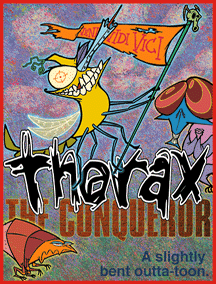Animation
World Magazine, Issue 1.12, March 1997
Going on Their Own in Vancouver
by Sean Maclennan Murch
 Sean
Murch
Sean
Murch
The Vancouver animation business is thriving.
Broadcast and production clients come from around the world to have their
shows designed, storyboarded, laid out and animated here. The city currently
houses over 10 classical animation studios working on a variety of feature,
television, interactive, and commercial projects. Local producers are widely
used by companies such as MTV, Nickelodeon, Disney, Nelvana, Fox, HBO,
and Warner Bros.; and this past year, Disney Television opened its own
studio in downtown Vancouver to produce, in conjunction with Disney Toronto,
direct-to-video features.
Companies such as International Rocketship, Gord Stanfeild Animation, and
Delany and Friends have been in business for well over a decade. Newer
studios include Studio B, Barking Bullfrog, A.K.A, Bardel and Natterjack
(where I am director of development). These companies have all enjoyed
a great deal of success and international recognition over the past decade.
Why then does it prove so difficult for local companies to get their own
projects financed? Much like the local live-action film industry, the majority
of production in Vancouver exists as contract work for larger, Los Angeles-based,
companies.
Many studios have come to realize that while this "service work"
is lucrative and often necessary for short-term survival, long-term growth
will ultimately be determined by the ownership of rights. For Studio B's
Blair Peters, creativity is also part of this equation. He notes that,
"The scripts we have coming in on a service basis aren't always our
cup of tea. Even though some of the projects we have now are good, like
Tex Avery Theater, which is a great show--we're really able to make
a cartoon the old way. Still, we have to rework and rewrite, make the gags
funny and develop the look of the characters. We don't mind doing that,
it's our job. But we don't own any of those characters. I think that's
why Studio B wants to do their own stuff. We've got artists here who are
good friends that we want to keep. To do that we have to involve them in
development and also look at their ideas."
The same holds true for Natterjack. While the quality of the contract work
we currently have is very high, it is also important to nurture the creativity
of our designers and animators. One of the best ways to do this is to develop
original projects we can call our own. Thus, we have recently begun development
on three internally-designed shows, which has done much to lift the general
mood of the studio. The trick, of course, is to find creative ways to finance
such development until a full production budget can be raised.
 Natterjack Animation's The Champ
Natterjack Animation's The Champ
The Co-Production Way
One of the more popular methods of easing into original production is to
do a co-production with a foreign studio. The supposition being that it
is easier to raise half of the financing domestically, relying on a partner
to raise the other half abroad. There are government incentives in place
for this type of international cooperation, but local studios are often
skeptical about the relative merits of such a move.
Peters, in talking about Studio B's tentative venture into this arena,
recalled that, one of its clients "wanted to do a co-production on
a show for which we did the first season. It wasn't doing well in the ratings,
so it wasn't in our best interests to do that as a co-production. What
I'd rather do is keep doing the service work, where you're guaranteed your
income, then pool that and develop our own shows. At that point we would
pursue possible co-production partners, broadcasters, and distributors.
That's our mandate anyway. Talk to me in a few weeks, and I may have changed
my mind."
Whether or not one goes the co-production route, there is still the issue
of how to secure a domestic presale. This is becoming more and more difficult
in today's climate. Canadian broadcasters often rely on the larger Eastern
producers, or look to the US for their animation programming. More often
than not, they are looking for finished programming, rather than a project
in development.
"Everyone wants a proven property," Blair points out "whether
it's a comic book, a toy, or whatever. That causes a problem for studios
that want to develop original properties. At some point someone has to
take a risk. That's what we're trying to convince the Canadian broadcasters
to do."
The Rocketship Solution
Marv Newland, of International Rocketship, found a different solution to
the lack of available financing. He has, for the past 15 years, produced
his own, original shows in their entirety before taking them to market.
Using the profits from his high-end service work, Marv is able to fund
at least one short each year. "The whole concept of the studio,"
he says, "was to produce our own animated films. We own those films,
so we have a library of shorts and are steadily adding to it."
How does Rocketship recoup its costs and get its shows to market? "It's
pretty easy, actually." Marv replied. "Selling the first one
is difficult, but once you've established a client list, those clients
pretty much stick around, especially European television. For a while,
we had to meet with people interested in our films. Now, whenever we enter
festivals--and we try to do all of the major festivals--if the film is
any good the broadcasters will fax you back a contract. You either go with
those terms, or maybe fax back to negotiate, then settle it and sign. There
are always new outlets for the films. This was a great year for royalties,
I don't know why, even early films like Sing Beast Sing and Anijam,
1980-1984 productions, did well.They are good and entertaining enough
so that, if someone hasn't seen them, they don't care what year it was
made in. That helps us a lot."
 Bardel Animation's Thorax the
Conqueror
Bardel Animation's Thorax the
Conqueror
A Balancing Act
Rocketship is in an enviable position. They have been in the business for
over 20 years, and have built up a loyal following. For many studios though,
it is a constant balancing act. The majority of Vancouver's animation houses
are animator owned and operated. Often these animator/owners are already
wearing a number of hats and they usually don't relish the idea of also
donning a suit and trying to "sell" their work.
"I don't want to be a distributor," Peters states. "In five
years I don't want to be at NATPE, wearing a suit, but at the same time
we know that right now people want to make the connection with our studio.
Once our first show is sold, I don't want to be selling individual territories
and all that. I'd rather have a distributor take its cut and give us the
money to work on the shows."
The sentiment is a common one. Wayne Sterloff, of BC Film, a local funding
agency, has been working at getting indigenous projects financed for many
years. Through BC Film, many Vancouver studios have access to development
and production financing. Wayne, who recognizes the need for local animators
to reach out to the marketplace, notes that, "There aren't many hard
core entrepreneurs in the animation community. A lot of the men and women
who are interested in animation come from a creative arts background, and
they're not interested at all in setting up a sales and distribution entity.
It may hurt them to spend money on advertising and promotion, and marketing
expenses, or to send a salesperson over to MIP-Asia, in Hong Kong, and
back. It's a real hurdle for most animators to get over, in terms of reaching
that goal of gaining some independence and creating security.
"There are a number of animation companies who have said, `Look, we've
got to secure our company and we want to buy some new technology. The bank
wants a 5-year projection that's based on having some assets, not just
bidding for service work.' But, on the other hand, the profit margin on
straight service work currently is fairly attractive, and people can see
a future there. But if you want to make your future more than 2 or 3 years
out, if you want to see a company that's here 5 or 10 years from now, you're
going to have to take a look at owning part of the assets that you're manufacturing."
In many cases, Vancouver studios have formed partnerships with existing
distributors, or have hired people to search out development financing.
There are also a number of executive producers at large who will work on
retainer, performing a similar service. This is one way to lessen the cost
of entering into development, though it generally requires that some of
the "back end" be given up in the process. At Natterjack, we
have realized the importance of allocating some funds to original production.
Whether its in the form of advertising or traveling to conferences such
as NATPE and MIP, a portion of the company's budget will always be devoted
to developing and financing our own product.
 Wayne Sterloff
Wayne Sterloff
Seeing the Light of Day
The truth is that Vancouver studios are moving forward with their
plans for self sufficiency. A number of projects within the last year have
tasted success. Mainframe's 3-D animated series, ReBoot, will be
in it's third season this year, while its new series, Beast Wars,
has been fully funded and is currently in production. Local animator Gord
Stanfield has presold his Kleo the Misfit Unicorn.. Herve Beddard
retains the North American rights to Billy the Cat. Chris Delany
is currently producing Nilus the Sandman. Slowly but surely, Vancouver
projects are seeing the light of day. It is a case of staying power, determination,
and developing the right property for the current market.
Marv Newland succinctly captures the prevailing sentiment among many local
animators when he says, "What else am I going to do with my life?
I love animation. I love making pictures. I would like it if I could just
sit in a room and make short films for the rest of my life. That's really
what interests me. It's the closest thing to what pure animation is all
about. I came up wrong. I didn't learn about working for TV series and
all that. I started making my own pictures.
"So, I think if you want to make an animated film, even commercials,
you make your storyboard, you design your characters, put some words in
their mouths if you need them, get some music, and that's that. As the
years go by, though, you do fewer of those things. You're handed things
to do and told how to do them, sometimes by people with little or no animation
experience. Each time someone hands you something to do, or tells you how
to do it, the less interested you become, and the more money you make.
So I'd just like to make my own pictures, and if there's some way I can
get a sandwich at lunch and a coffee, and do some surfing, and have a roof
over my head, then that's what I'd do."
Sean Maclennan Murch spent four years in London working as both a producer
and executive producer. For the last two years he has been based in Vancouver,
where he is currently employed as the Director of Development at Natterjack
Animation Co. Ltd.
Back to the Table of Contents
Feedback?
Past Issues
![]()
![]()
![]()
![]()
![]()
![]()
[about | help
| home | info@awn.com
| mail | register]